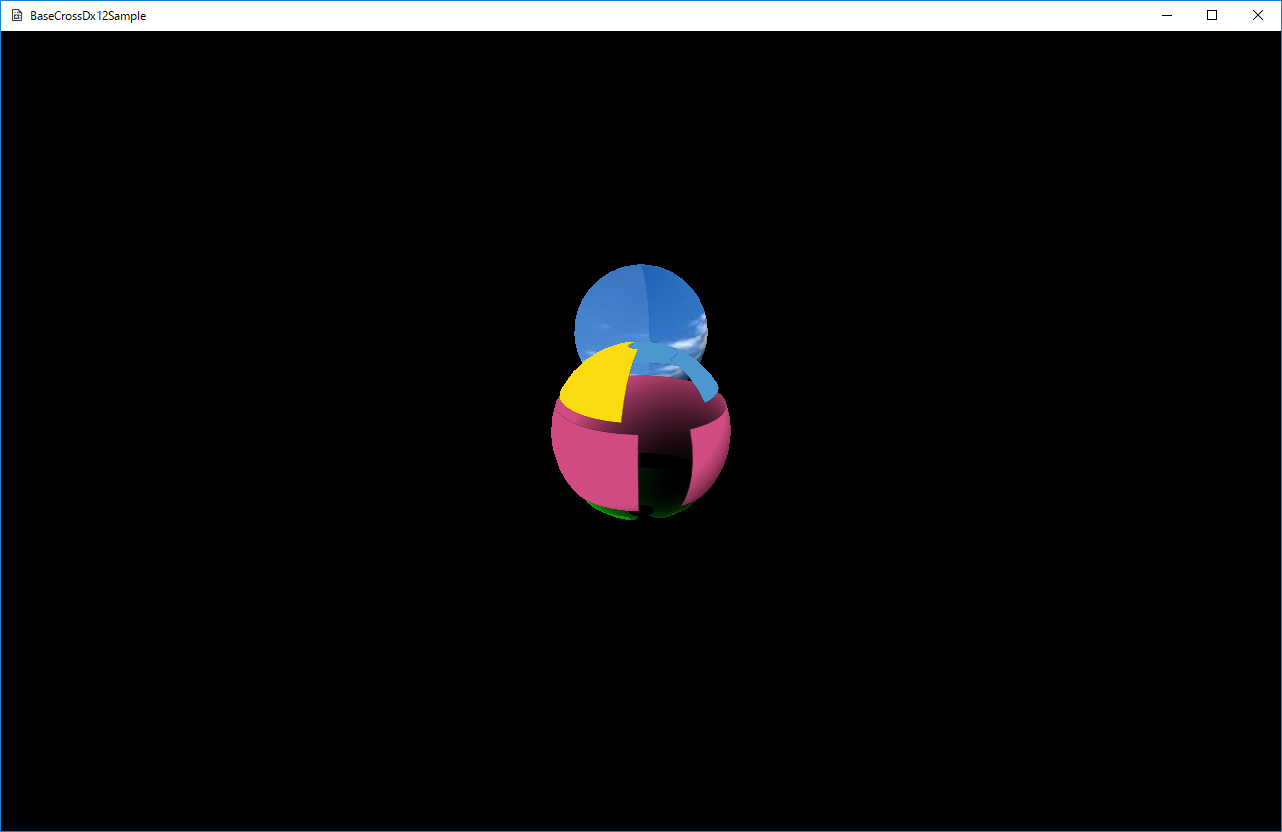0.シンプルバージョンサンプル(Dx12版)
012.テクスチャ付き球体の描画(Dx12版)
このサンプルはSimplSample012というディレクトリに含まれます。BaseCrossDx12.slnというソリューションを開くとDx12版が起動します。
実行結果は以下のような画面が出ます。

図0012a
動画は以下になります。
【サンプルのポイント】
今項のサンプルは前項のサンプルの形状を変えたものです。前項では、Dx12リソースの初期化について、あえてBaseCrossのユーティリティ関数は使わずに、実装してみました。今項では、BaseCrossのユーティリティ関数を使って実装します。前項のサンプルと比べることで、どのくらいユーティリティ関数が何をやっているのかを理解してもらえればと思います。【共通解説】
Dx12、Dx11両方に共通なのはシェーダーです。DxSharedプロジェクト内にシェーダファイルというフィルタがあり、そこに記述されてます。今回使用するシェーダは頂点シェーダとピクセルシェーダです。VertexPositionNormalTexture型の頂点を持つものです。コンスタントバッファもあります。
更新処理は動きは同じですが、Dx12版の更新処理で説明します。OnUpdate()関数には、更新する方法が記述されています。
【Dx12版解説】
BaseCrossDx12.slnを開くと、BaseCrossDx12というメインプロジェクトがあります。この中のCharacter.h/cppが主な記述個所になります。■初期化■
初期化は、まず頂点の配列、インデックスの配列を初期化しメッシュを作成します。インスタンス構築時のパラメータで法線の作成方法を変えます。SphereObject::CreateBuffers()関数でその処理をしています。
void SphereObject::CreateBuffers() {
float Radius = 0.5f;
//緯度方向
UINT Vertical = m_Division;
//経度方向
UINT Horizontal = m_Division * 2;
vector<VertexPositionNormalTexture> vertices;
for (UINT i = 0; i <= Vertical; i++)
{
float v = 1 - (float)i / Vertical;
float Latitude = (i * XM_PI / Vertical) - XM_PIDIV2;
float Dy = sin(Latitude);
float Dxz = cos(Latitude);
for (UINT j = 0; j <= Horizontal; j++)
{
float u = 1 - (float)j / Horizontal;
float Longitude = j * XM_2PI / Horizontal;
float Dx = sin(Longitude) * Dxz;
float Dz = cos(Longitude) * Dxz;
Vec3 normal(Dx, Dy, Dz);
VertexPositionNormalTexture Data;
Data.position = normal * Radius;
Data.normal = normal;
Data.normal.normalize();
Data.textureCoordinate = Vec2(u, v);
vertices.push_back(Data);
}
}
UINT Stride = Horizontal + 1;
vector<uint16_t> indices;
for (UINT i = 0; i < Vertical; i++)
{
for (UINT j = 0; j <= Horizontal; j++)
{
UINT NextI = i + 1;
UINT NextJ = (j + 1) % Stride;
indices.push_back((uint16_t)(i * Stride + NextJ));
indices.push_back((uint16_t)(NextI * Stride + j));
indices.push_back((uint16_t)(i * Stride + j));
indices.push_back((uint16_t)(NextI * Stride + NextJ));
indices.push_back((uint16_t)(NextI * Stride + j));
indices.push_back((uint16_t)(i * Stride + NextJ));
}
}
//メッシュの作成(変更できない)
m_SphereMesh = MeshResource::CreateMeshResource(vertices, indices, false);
}
メッシュを作成したらDX12リソースの初期化を行います。
■初期化のメカニズム■
今回のサンプルでは、前項ではべたに記述しましたが、BaseCrossのユーティリティ関数を使用してDx12リソースを作成します。ぜひ前項との違いを確認してください。
■ルートシグネチャ作成■
SphereObject::CreateRootSignature()関数です。テクスチャ(シェーダリソース)、サンプラー、コンスタントバッファを持つルートシグネチャです。
void SphereObject::CreateRootSignature() {
//ルートシグネチャ
m_RootSignature = RootSignature::CreateSrvSmpCbv();
}
■デスクプリタヒープ作成■
SphereObject::CreateDescriptorHeap()関数です。ルートシグネチャ同様、テクスチャ(シェーダリソース)、サンプラー、コンスタントバッファを持つデスクプリタヒープです。
void SphereObject::CreateDescriptorHeap() {
auto Dev = App::GetApp()->GetDeviceResources();
m_CbvSrvDescriptorHandleIncrementSize =
Dev->GetDevice()->GetDescriptorHandleIncrementSize(D3D12_DESCRIPTOR_HEAP_TYPE_CBV_SRV_UAV);
//CbvSrvデスクプリタヒープ
m_CbvSrvUavDescriptorHeap = DescriptorHeap::CreateCbvSrvUavHeap(1 + 1);
//サンプラーデスクプリタヒープ
m_SamplerDescriptorHeap = DescriptorHeap::CreateSamplerHeap(1);
//GPU側デスクプリタヒープのハンドルの配列の作成
m_GPUDescriptorHandleVec.clear();
CD3DX12_GPU_DESCRIPTOR_HANDLE SrvHandle(
m_CbvSrvUavDescriptorHeap->GetGPUDescriptorHandleForHeapStart(),
0,
0
);
m_GPUDescriptorHandleVec.push_back(SrvHandle);
CD3DX12_GPU_DESCRIPTOR_HANDLE SamplerHandle(
m_SamplerDescriptorHeap->GetGPUDescriptorHandleForHeapStart(),
0,
0
);
m_GPUDescriptorHandleVec.push_back(SamplerHandle);
CD3DX12_GPU_DESCRIPTOR_HANDLE CbvHandle(
m_CbvSrvUavDescriptorHeap->GetGPUDescriptorHandleForHeapStart(),
1,
m_CbvSrvDescriptorHandleIncrementSize
);
m_GPUDescriptorHandleVec.push_back(CbvHandle);
}
■サンプラー作成■
SphereObject::CreateSampler()関数です。
void SphereObject::CreateSampler() {
auto SamplerDescriptorHandle = m_SamplerDescriptorHeap->GetCPUDescriptorHandleForHeapStart();
DynamicSampler::CreateSampler(SamplerState::LinearClamp, SamplerDescriptorHandle);
}
■シェーダーリソースビュー作成■
SphereObject::CreateShaderResourceView()関数です。
void SphereObject::CreateShaderResourceView() {
auto Dev = App::GetApp()->GetDeviceResources();
//テクスチャハンドルを作成
CD3DX12_CPU_DESCRIPTOR_HANDLE Handle(
m_CbvSrvUavDescriptorHeap->GetCPUDescriptorHandleForHeapStart(),
0,
0
);
//テクスチャのシェーダリソースビューを作成
D3D12_SHADER_RESOURCE_VIEW_DESC srvDesc = {};
srvDesc.Shader4ComponentMapping = D3D12_DEFAULT_SHADER_4_COMPONENT_MAPPING;
//フォーマット
srvDesc.Format = m_TextureResource->GetTextureResDesc().Format;
srvDesc.ViewDimension = D3D12_SRV_DIMENSION_TEXTURE2D;
srvDesc.Texture2D.MipLevels = m_TextureResource->GetTextureResDesc().MipLevels;
//シェーダリソースビュー
Dev->GetDevice()->CreateShaderResourceView(
m_TextureResource->GetTexture().Get(),
&srvDesc,
Handle);
}
■コンスタントバッファ作成■
SphereObject::CreateConstantBuffer()関数です。
void SphereObject::CreateConstantBuffer() {
auto Dev = App::GetApp()->GetDeviceResources();
//コンスタントバッファは256バイトにアラインメント
UINT ConstBuffSize = (sizeof(StaticConstantBuffer) + 255) & ~255;
//コンスタントバッファリソース(アップロードヒープ)の作成
ThrowIfFailed(Dev->GetDevice()->CreateCommittedResource(
&CD3DX12_HEAP_PROPERTIES(D3D12_HEAP_TYPE_UPLOAD),
D3D12_HEAP_FLAG_NONE,
&CD3DX12_RESOURCE_DESC::Buffer(ConstBuffSize),
D3D12_RESOURCE_STATE_GENERIC_READ,
nullptr,
IID_PPV_ARGS(&m_ConstantBufferUploadHeap)),
L"コンスタントバッファ用のアップロードヒープ作成に失敗しました",
L"Dev->GetDevice()->CreateCommittedResource()",
L"SphereObject::CreateConstantBuffer()"
);
//コンスタントバッファのビューを作成
D3D12_CONSTANT_BUFFER_VIEW_DESC cbvDesc = {};
cbvDesc.BufferLocation = m_ConstantBufferUploadHeap->GetGPUVirtualAddress();
cbvDesc.SizeInBytes = ConstBuffSize;
//コンスタントバッファビューを作成すべきデスクプリタヒープ上のハンドルを取得
//シェーダリソースがある場合コンスタントバッファはシェーダリソースビューのあとに設置する
CD3DX12_CPU_DESCRIPTOR_HANDLE cbvSrvHandle(
m_CbvSrvUavDescriptorHeap->GetCPUDescriptorHandleForHeapStart(),
1,
m_CbvSrvDescriptorHandleIncrementSize
);
Dev->GetDevice()->CreateConstantBufferView(&cbvDesc, cbvSrvHandle);
//コンスタントバッファのアップロードヒープのマップ
CD3DX12_RANGE readRange(0, 0);
ThrowIfFailed(m_ConstantBufferUploadHeap->Map(0, &readRange,
reinterpret_cast<void**>(&m_pConstantBuffer)),
L"コンスタントバッファのマップに失敗しました",
L"pImpl->m_ConstantBufferUploadHeap->Map()",
L"SphereObject::CreateConstantBuffer()"
);
}
■パイプラインステート作成■
SphereObject::CreatePipelineState()関数です。透明処理をするかしないかで処理を分けてますの注意しましょう。CullBack、CullFrontの2種類のパイプラインステートを作成しています。
void SphereObject::CreatePipelineState() {
//パイプラインステートの作成
D3D12_GRAPHICS_PIPELINE_STATE_DESC PineLineDesc;
PipelineState::CreateDefault3D<VertexPositionNormalTexture,
VSPNTStatic, PSPNTStatic>(m_RootSignature, PineLineDesc);
//ブレンドステートとラスタライザ差し替え
if (m_Trace) {
D3D12_BLEND_DESC blend_desc;
D3D12_RENDER_TARGET_BLEND_DESC Target;
ZeroMemory(&blend_desc, sizeof(blend_desc));
blend_desc.AlphaToCoverageEnable = false;
blend_desc.IndependentBlendEnable = false;
ZeroMemory(&Target, sizeof(Target));
Target.BlendEnable = true;
Target.SrcBlend = D3D12_BLEND_SRC_ALPHA;
Target.DestBlend = D3D12_BLEND_INV_SRC_ALPHA;
Target.BlendOp = D3D12_BLEND_OP_ADD;
Target.SrcBlendAlpha = D3D12_BLEND_ONE;
Target.DestBlendAlpha = D3D12_BLEND_ZERO;
Target.BlendOpAlpha = D3D12_BLEND_OP_ADD;
Target.RenderTargetWriteMask = D3D12_COLOR_WRITE_ENABLE_ALL;
for (UINT i = 0; i < D3D12_SIMULTANEOUS_RENDER_TARGET_COUNT; i++) {
blend_desc.RenderTarget[i] = Target;
}
PineLineDesc.BlendState = blend_desc;
}
PineLineDesc.RasterizerState.FillMode = D3D12_FILL_MODE::D3D12_FILL_MODE_SOLID;
PineLineDesc.RasterizerState.CullMode = D3D12_CULL_MODE::D3D12_CULL_MODE_FRONT;
m_CullFrontPipelineState = PipelineState::CreateDirect(PineLineDesc);
PineLineDesc.RasterizerState.CullMode = D3D12_CULL_MODE::D3D12_CULL_MODE_BACK;
m_CullBackPipelineState = PipelineState::CreateDirect(PineLineDesc);
}
■コマンドリスト作成■
SphereObject::CreateCommandList()関数です。
void SphereObject::CreateCommandList() {
//コマンドリストは裏面カリングに初期化
m_CommandList = CommandList::CreateDefault(m_CullBackPipelineState);
CommandList::Close(m_CommandList);
}
■コンスタントバッファの更新■
SphereObject::UpdateConstantBuffer()関数です。
void SphereObject::UpdateConstantBuffer() {
//行列の定義
Mat4x4 World, View, Proj;
//ワールド行列の決定
World.affineTransformation(
m_Scale, //スケーリング
Vec3(0, 0, 0), //回転の中心(重心)
m_Qt, //回転角度
m_Pos //位置
);
//転置する
World.transpose();
//ビュー行列の決定
View = XMMatrixLookAtLH(Vec3(0, 2.0, -5.0f), Vec3(0, 0, 0), Vec3(0, 1.0f, 0));
//転置する
View.transpose();
//射影行列の決定
float w = static_cast<float>(App::GetApp()->GetGameWidth());
float h = static_cast<float>(App::GetApp()->GetGameHeight());
Proj = XMMatrixPerspectiveFovLH(XM_PIDIV4, w / h, 1.0f, 100.0f);
//転置する
Proj.transpose();
//ライティング
Vec4 LightDir(0.5f, -1.0f, 0.5f, 0.0f);
LightDir.normalize();
m_StaticConstantBuffer.World = World;
m_StaticConstantBuffer.View = View;
m_StaticConstantBuffer.Projection = Proj;
m_StaticConstantBuffer.LightDir = LightDir;
m_StaticConstantBuffer.Diffuse = Col4(1.0f, 1.0f, 1.0f, 1.0f);
m_StaticConstantBuffer.Emissive = Col4(0.4f, 0.4f, 0.4f, 0);
//更新
memcpy(m_pConstantBuffer, reinterpret_cast<void**>(&m_StaticConstantBuffer),
sizeof(m_StaticConstantBuffer));
}
■更新処理■
SphereObject::OnUpdate()関数です。オブジェクトを回転させています。■描画処理■
SphereObject::DrawObject()関数です。透明処理の描画方法を確認してください。
透明の場合は、背面をまず描画してから表面を描画します。(つまり2回描画します)
void SphereObject::DrawObject() {
//コマンドリストのリセット
if (m_Trace) {
CommandList::Reset(m_CullFrontPipelineState, m_CommandList);
}
else {
CommandList::Reset(m_CullBackPipelineState, m_CommandList);
}
m_SphereMesh->UpdateResources<VertexPositionNormalTexture>(m_CommandList);
m_TextureResource->UpdateResources(m_CommandList);
//描画
m_CommandList->SetGraphicsRootSignature(m_RootSignature.Get());
ID3D12DescriptorHeap* ppHeaps[] = { m_CbvSrvUavDescriptorHeap.Get(),
m_SamplerDescriptorHeap.Get() };
m_CommandList->SetDescriptorHeaps(_countof(ppHeaps), ppHeaps);
for (size_t i = 0; i < m_GPUDescriptorHandleVec.size(); i++) {
m_CommandList->SetGraphicsRootDescriptorTable(i, m_GPUDescriptorHandleVec[i]);
}
auto Dev = App::GetApp()->GetDeviceResources();
m_CommandList->RSSetViewports(1, &Dev->GetViewport());
m_CommandList->RSSetScissorRects(1, &Dev->GetScissorRect());
CD3DX12_CPU_DESCRIPTOR_HANDLE rtvHandle(
Dev->GetRtvHeap()->GetCPUDescriptorHandleForHeapStart(),
Dev->GetFrameIndex(),
Dev->GetRtvDescriptorSize());
CD3DX12_CPU_DESCRIPTOR_HANDLE dsvHandle(
Dev->GetDsvHeap()->GetCPUDescriptorHandleForHeapStart()
);
m_CommandList->OMSetRenderTargets(1, &rtvHandle, FALSE, &dsvHandle);
m_CommandList->IASetPrimitiveTopology(D3D_PRIMITIVE_TOPOLOGY_TRIANGLELIST);
m_CommandList->IASetIndexBuffer(&m_SphereMesh->GetIndexBufferView());
m_CommandList->IASetVertexBuffers(0, 1, &m_SphereMesh->GetVertexBufferView());
m_CommandList->DrawIndexedInstanced(m_SphereMesh->GetNumIndicis(), 1, 0, 0, 0);
if (m_Trace) {
m_CommandList->SetPipelineState(m_CullBackPipelineState.Get());
m_CommandList->DrawIndexedInstanced(m_SphereMesh->GetNumIndicis(), 1, 0, 0, 0);
}
//コマンドリストのクローズ
CommandList::Close(m_CommandList);
//デバイスにコマンドリストを送る
Dev->InsertDrawCommandLists(m_CommandList.Get());
}
以上、Dx12側の説明は終わりです。
BaseCrossのユーティリティ関数を使用することで、いくらか負担が軽減されているリソースもあると思います。